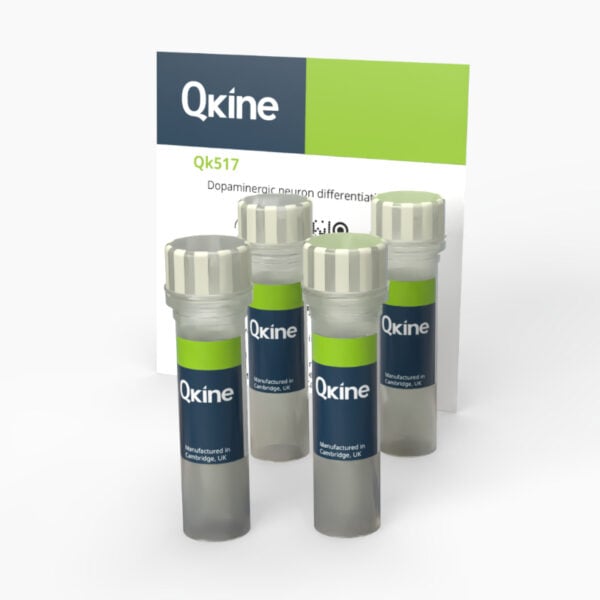Dopaminergic neuron differentiation kit
QK517
Brand: Qkine
For validating the ability of induced pluripotent stem (iPSC) lines to differentiate into dopaminergic neurons.
The dopaminergic neuron differentiation kit is a comprehensive tool designed to assess and confirm the differentiation potential of both newly derived and established iPSC lines. This kit enables researchers to evaluate the ability of iPSCs to differentiate into dopaminergic neurons, a specialized neuronal subtype essential for motor control, reward processing, and cognitive functions. Dopaminergic neurons play a crucial role in neurological health, and their degeneration is a hallmark of Parkinson’s disease.
The kit includes carefully optimized growth factors required to efficiently guide iPSCs toward the dopaminergic neurons. Each kit is sufficient for differentiation of 2x 96 well plates for 35 days.

Currency:
| Product name | Catalog number | Pack size | Price | Price (USD) | Price (GBP) | Price (EUR) |
|---|---|---|---|---|---|---|
| Dopaminergic neuron differentiation kit | QK517 | 1 kit | (select above) | $ 655.00 | £ 505.00 | € 295.00 |
Note: prices shown do not include shipping and handling charges.
Qkine company name and logo are the property of Qkine Ltd. UK.
Summary
- >98%, by SDS-PAGE quantitative densitometry
- Animal origin-free (AOF) and carrier protein-free
- Expressed in E. coli
- Bioactivity Guaranteed
- Manufactured in Qkine's Cambridge, UK laboratories
- Lyophilized
- See reconstitution instructions for individual kit components
Further quality assays
- Mass spectrometry: single species with expected mass
- Recovery from stock vial: >95%
- Endotoxin: <0.005 EU/μg protein (below level of detection)
Featured applications
- Differentiation of midbrain dopaminergic neurons
Kit constituents
- Human BDNF – Qk050 – 25 µg
Used to maintain neurons and differentiate and mature human pluripotent stem cell-derived neural progenitors to cortical and motor neurons and cortical organoids. - Human GDNF – Qk051 – 25 µg
Used to maintain neurons and cortical organoids and to differentiate dopaminergic neurons from human pluripotent stem cell-derived neural progenitors. GDNF also facilitates the differentiation of neural progenitors to astrocytes. - Human TGF-ß3 – Qk054 – 25 µg
Member of the TGF-β family, a family involved in regulating cell survival, proliferation and differentiation. TGF-β3 is used in human pluripotent stem cell maintenance media. - Human FGF-8a – Qk059 – 25 µg
Often used for the differentiation of induced pluripotent stem cells, embryonic stem cells, and neural stem cells.
Protein background
Dopaminergic neurons are specialized nerve cells responsible for the synthesis, storage, and release of the neurotransmitter dopamine. These neurons play a pivotal role in several critical brain functions, including motor control, reward, motivation, and regulation of mood [1]. Dopaminergic neurons are primarily located in the substantia nigra and the ventral tegmental area of the brain. They project to various brain regions, including the striatum, prefrontal cortex, and limbic system, forming complex networks that influence a variety of behaviors and physiological processes [2].
Dopaminergic neurons are crucial in motor control, as evidenced by their degeneration in Parkinson’s disease, a condition characterized by motor symptoms such as tremors, rigidity, and bradykinesia. In psychiatric disorders, dysregulation of dopaminergic signaling is implicated. For instance, hyperactivity of dopaminergic pathways is associated with the positive symptoms of schizophrenia, while diminished dopamine function is linked to anhedonia and lack of motivation seen in depression [2]. Differentiating iPSCs into dopaminergic neurons is an area of research with significant implications for treating neurological disorders, especially Parkinson’s disease.
Background references
- O Klein, M. et al. Dopamine: Functions, Signaling, and Association with Neurological Diseases. Cellular and Molecular Neurobiology. 2019 Jan;39(1):31-59. doi: 10.1007/s10571-018-0632-3
- Zhuang, Y. et al. Mechanism of dopamine binding and allosteric modulation of the human D1 dopamine receptor. Cell Research 2021 May;31(5):593-596. doi.org/10.1038/s41422-021-00482-0